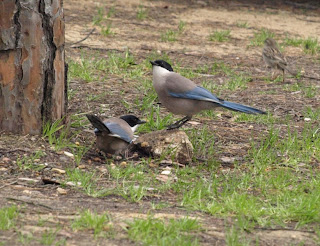The Alhambra is a fortress and collection of palaces set in large, beautiful gardens in Granada.
Its name comes from the Arabic name of the original fortress in the eleventh century – “Al Qal’a al-Hamra” which means “the red fort” now known as the Alcazaba.
It was rebuilt and extended by Muhammed I ibn Nasr after his capture of Granada (soon to be his capital) in 1237, in 1238 he captured Almería and built the Alcazaba there that impressed us so much (see last posting). His greatest feat was to divert the River Darro nearly 8 km to the foot of the hill making possible the extensive engineering which supplies water to the whole complex. He founded the Nazarid Dynasty and a hundred years later his descendants Yussuf I and Muhammad V built the Nazarid Palaces.
The present united Spanish Kingdom was really established by Fernando and Isabella in the 15th Century and in 1492, they finally captured Granada, the last Moorish stronghold in Spain
(The Moors were the north African Muslims, mostly Berber from Morocco, including the Nazarids). They converted the Mosque to a Christian Church but did little else to the Alhambra. It was their grandson Carlos V who destroyed much of the Arabic architecture and art and built a Palace complete with its own bullring in the centre.
His successors allowed the complex to fall into disrepair and it was used as a prison in the eighteenth century. In 1812 it was captured by Napoleon’s forces who looted the Palaces and tried to blow them up before retreating but they were saved by an injured soldier – José Garcia – who remained behind and removed the fuses. 200 years later the American writer Washington Irving “discovered” the Alhambra and wrote his “Tales of the Alhambra” following which it was made a National Monument and the painstaking restoration of its Moorish origins continues today.
Having seen work by the same craftsmen in Morocco last year, what we saw brought back many memories which enabled us to understand the significance of what we saw in the Alhambra.
In particular we understood the extensive use of water which was a symbol of power – the one who controls the water controls the whole of the life of an area.
The walk back to our bus to the campsite took us through the pleasant city of Grenada ...
... past the enormous Cathedral outside of which were stalls selling every kind of tea and herbal infusion imaginable as well as some spices.
The following day we drove to another city with another Cathedral – Jaen. There were also some Moorish baths beneath a palace that is now a museum. In neither the Cathedral nor the Museum was photography allowed! Driving north we soon arrived at the site at Santa Elena with its pine trees and beautiful azure winged magpies that had so delighted us when we stayed here last year.










No comments:
Post a Comment